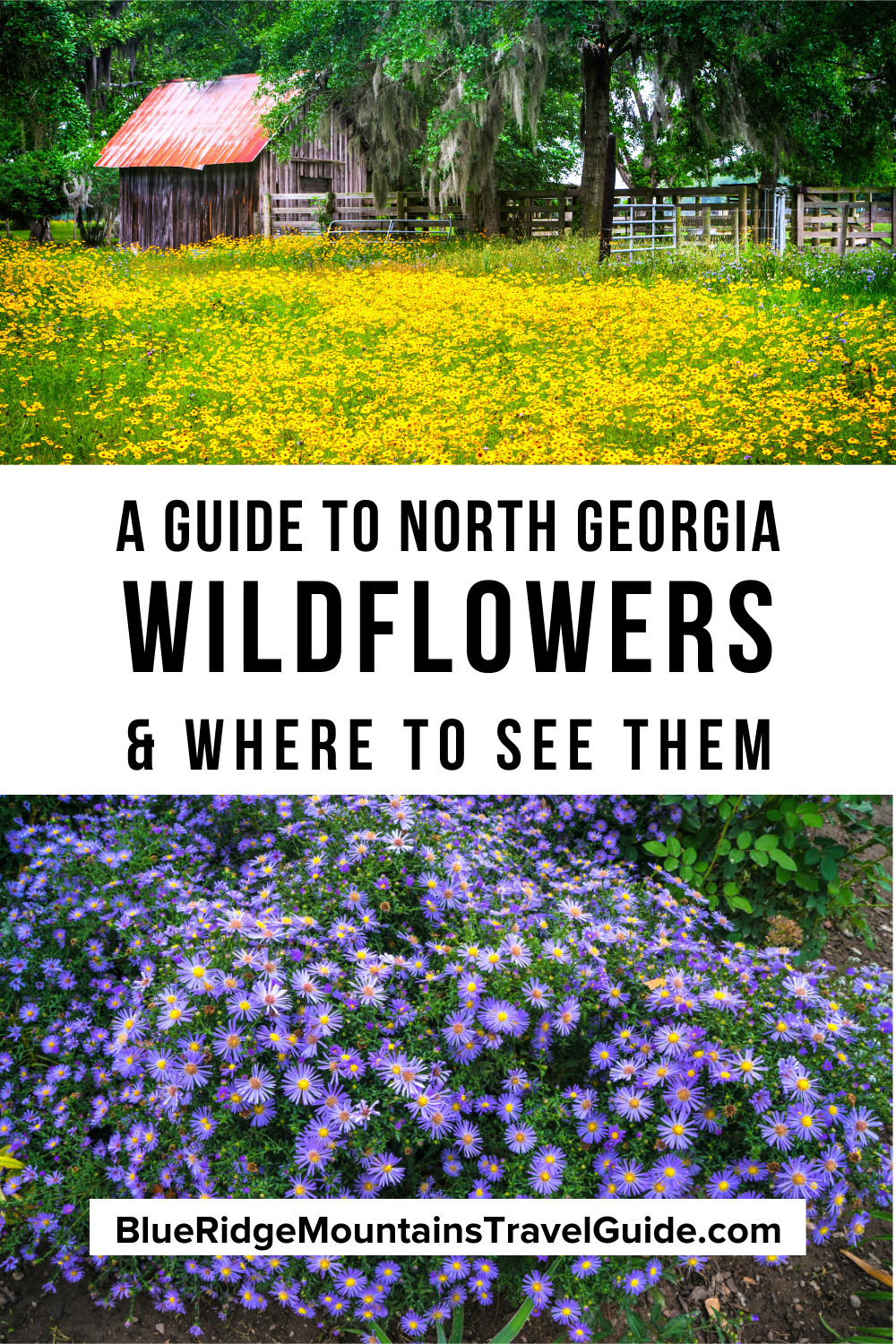[Updated 3/16/22] North Georgia boasts an incredibly diverse array of flora, including an abundance of eye-catching wildflowers that paint the landscape in vivid colors every spring.
From the brilliant blooms of Flame Azaleas and Catawba Rhododendrons to the more subdued beauty of Virginia Bluebells and Bloodroot, spotting wildflowers is one of our favorite things to do in North Georgia.
To help you learn a little more about the various species you might see, we’ve compiled this guide to some of the most common North Georgia wildflowers, along with some of the best places to see them!
READ MORE: The 20 Best North Georgia Waterfalls (& How to Get to Them)
North GA Wildflowers Guide
- Bloodroot (Sanguinaria canadensis)
- Trout-Lily (Erythronium americanum)
- Dutchman’s Breeches (Dicentra cucullaria)
- Pink Lady’s Slipper (Cypripedium acaule)
- Flame Azalea (Rhododendron calendulaceum)
- Mountain Laurel (Kalmia latifolia)
- Blue Violet (Viola Sororia)
- Dwarf Crested Iris (Iris cristata)
- Foam Flower (Tiarella cordifolia)
- White Trillium (Trillium grandiflorum)
- Fire Pink (Silene virginicia)
- Georgia Aster
- Jack in the Pulpit (Arisaema triphyllum)
- Virginia Bluebells (Mertensia virginica)
- Solomon’s Plume (Maianthemum racemosum)
- Fringed Polygala (Polygala paucifolia)
- Blue-eyed Grass (Sisyrinchium augustifolium)
- Ironweed (Veronia gigantea)
- Mouse-Ear Coreopsis (Coreopsis auriculata)
- White Milkweed (Asclepias variegata)
- Catawba Rhododendron (Rhododendron catawbiense)
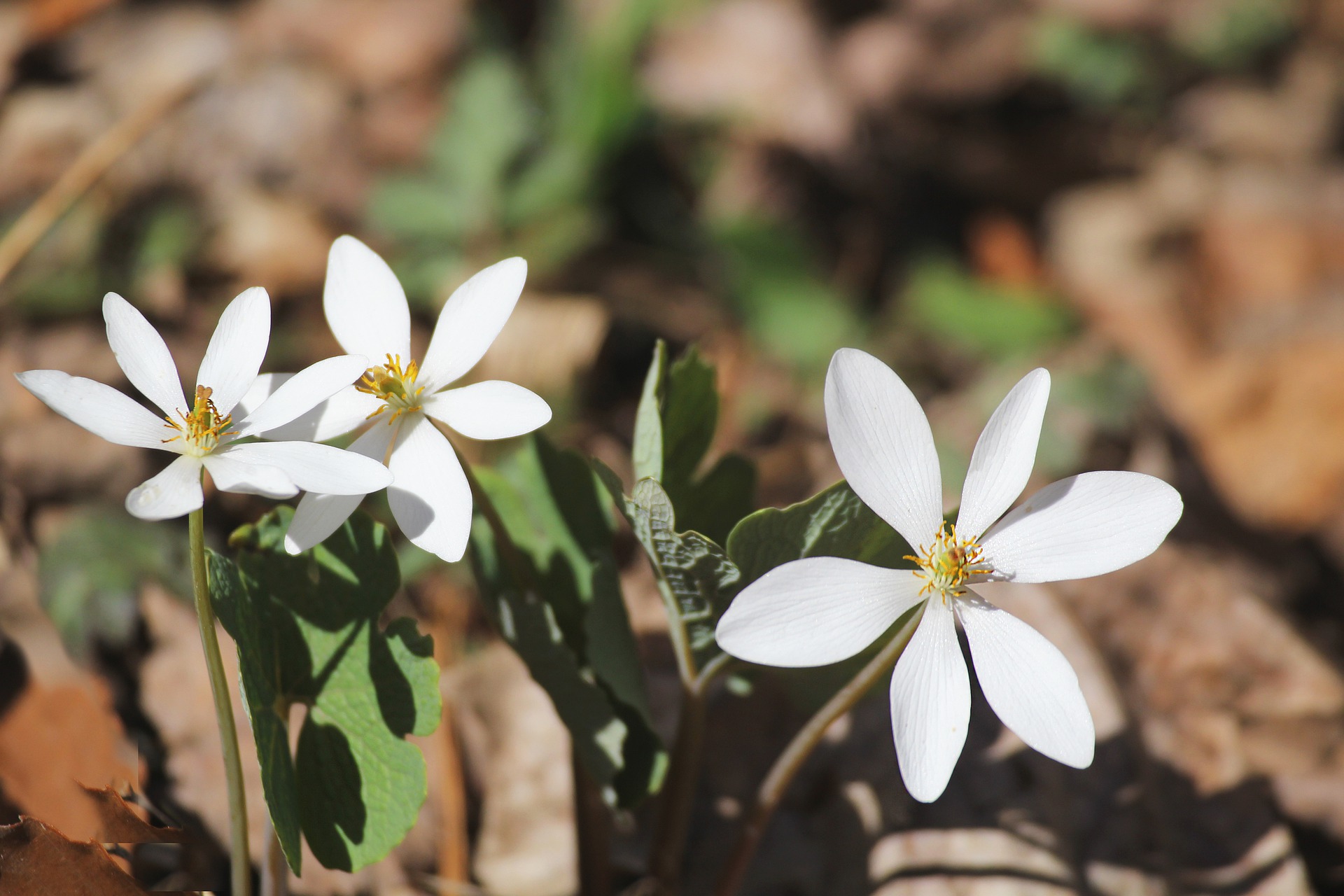
1. Bloodroot
(Sanguinaria canadensis)
One of the first GA wildflowers to bloom every year in spring, the Bloodroot is a member of the poppy family and is one of the most popular perennial wildflowers.
These relatively small flowers are native to the Eastern United States and grow best in partly sunny locations, such as deciduous hardwood forests.
They typically bloom from mid-March through April, with large green leaves and 6 to 10 white petals that open in full sun and close at night.
This wildflower’s name comes from the blood-like juice on the inside of their roots. This red juice was traditionally used for medical purposes (sore throat, congestion, fevers, etc).
The Blood Root was also used by Native Americans as a dye for baskets and clothing, as well as for war paint!
READ MORE: 52 Best Georgia Hiking Trails for the 52 Hikes Challenge
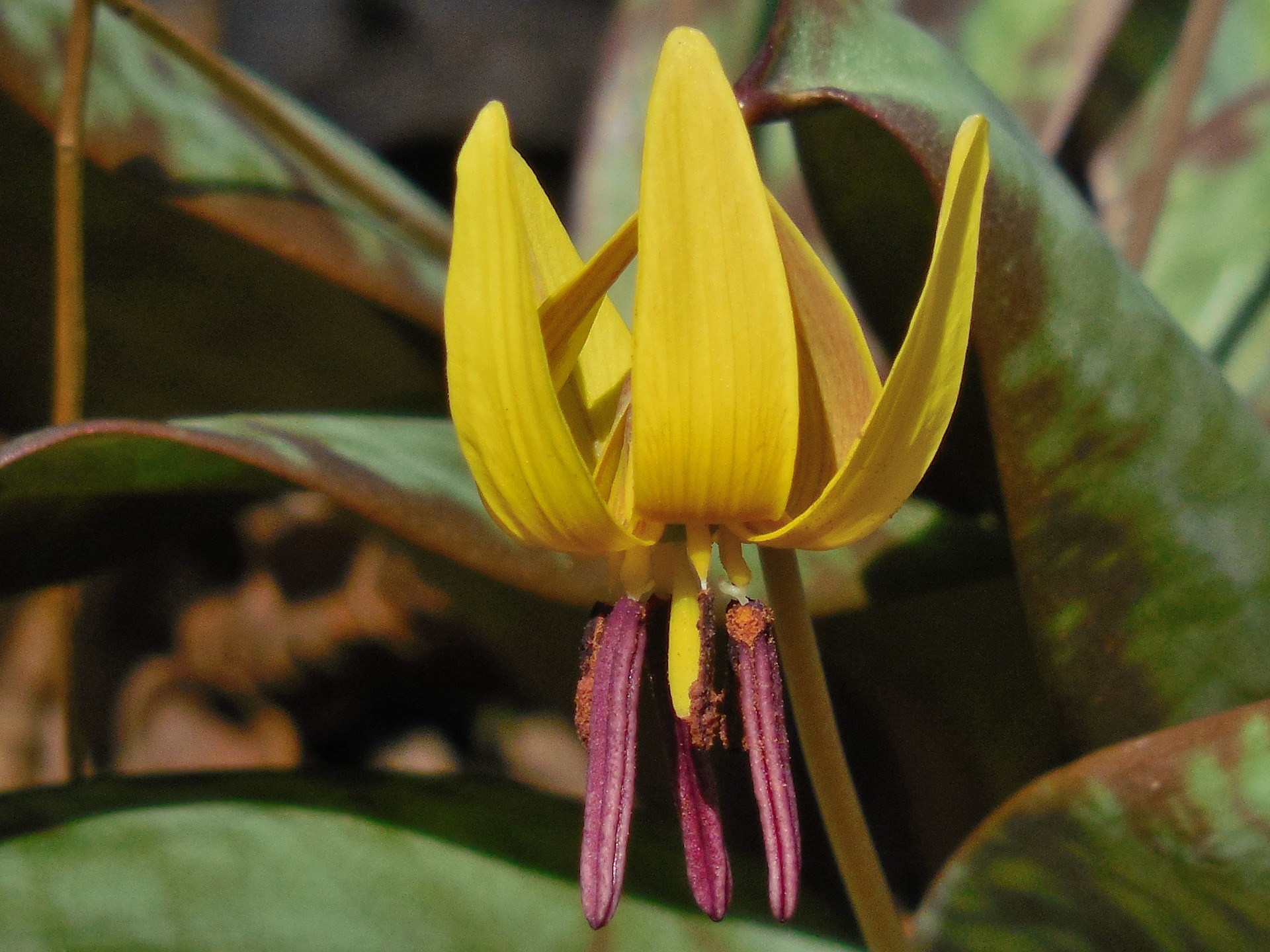
2. Trout-Lily
(Erythronium americanum)
Though this wildflower is also known as the Dog-Tooth Violet, Trout-Lily is a much more accurate name.
These unique GA wildflowers are not violets, but instead belong to the lily family.
The name Trout-Lily comes from the flower’s lance-shaped leaves, which are dotted with brown markings similar to those found on Brook Trout.
They are colony-forming perennial flowers that can be found in deciduous forest. They bloom in early spring so that they can get ample sunlight before the trees grow their leaves back.
The actual Trout-Lily flower grows anywhere from 3 to 6 inches, with yellow petals that curl backwards to showcase their brown stamens.
There are several species of erythronium lilies native to North America, but the Trout-Lily can be distinguished by its yellow petals.
Other species usually have pink or white flowers.
READ MORE: The 15 Best Lakes in the North Georgia Mountains
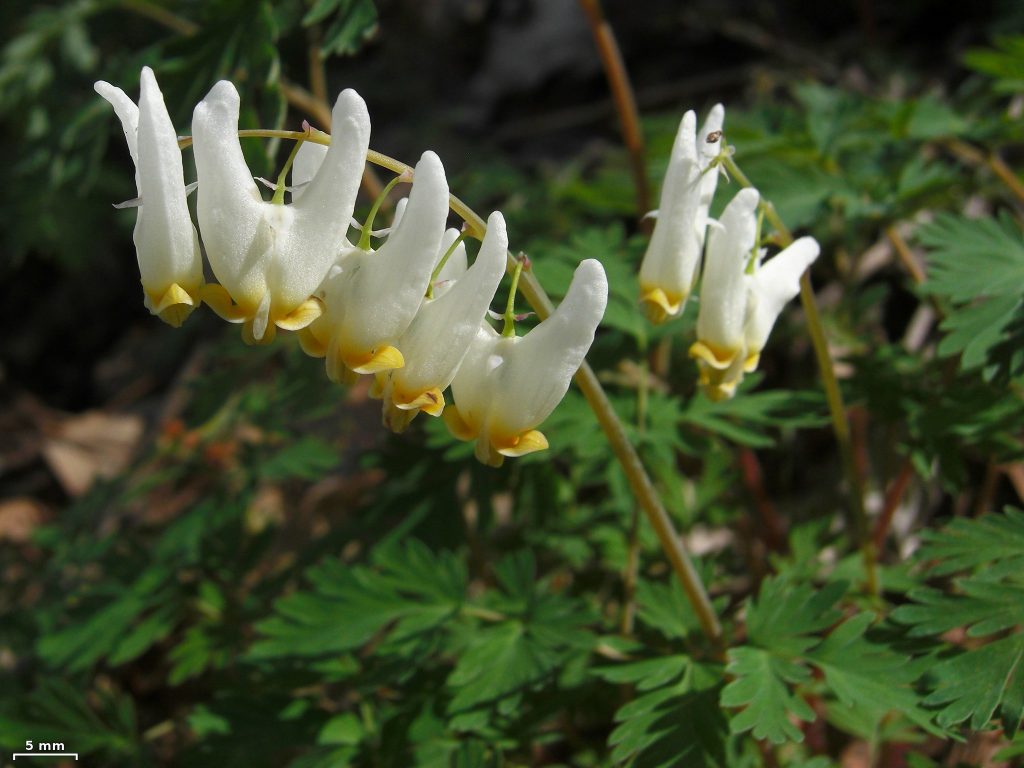
3. Dutchman’s Breeches
(Dicentra cucullaria)
Dutchman’s Breeches are one of the more unusual white wildflowers in Georgia.
They typically grow to be about 10 inches high and sport fern-like leaves. But their highlight is a naked flower stalk that has a row of nodding white flowers.
The Dutchman’s Breeches name comes from the unique shape of the flower petals, which resemble a pair of pants (or breeches) hanging upside down from a clothesline.
This woodland perennial grows best in deciduous forests and ravines.
Their prime blooming period is in early spring, and they are dependent on bumblebees for cross-pollination.
The unique structure of the Dutchman’s Breeches flower indicates that it has adapted to accommodate these bees, which can separate the inner and outer petals of the flower with their legs.
READ MORE: The 25 Best Hiking Trails in North Georgia Bucket List
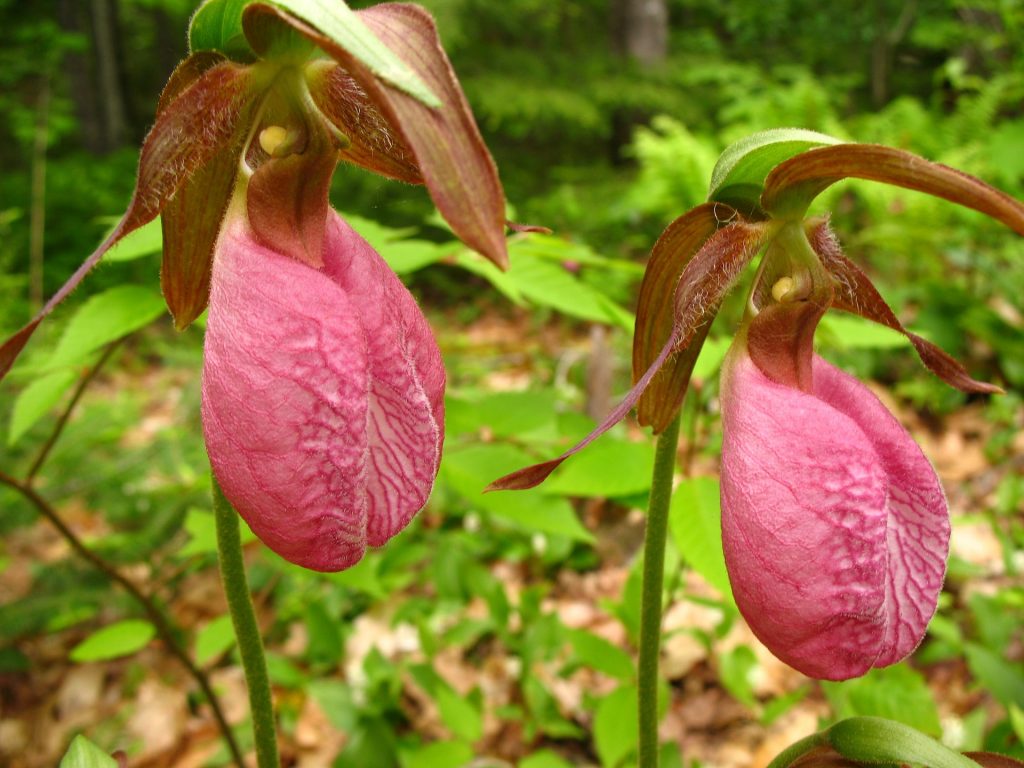
4. Pink Lady’s Slipper
(Cypripedium acaule)
Also known as the Moccasin Flower, the Pink Lady’s Slipper is one of 103 plants protected under provisions of the Georgia Wildflower Preservation Act of 1973.
They are one of the Peach State’s largest native orchids, growing up to 15 inches tall.
These fantastic flowers bear a beautiful pink inflated petal, with darker veins running along the surface.
Pink Lady’s Slippers form a symbiotic relationship with a soil fungus that is crucial to their growth.
Without it, they would wither away after three to five years, but with it they can live up to 20 years!
If you’re lucky, you may come across several hundred of these flowers within a small area while hiking the Blue Ridge Mountains of North Georgia.
Your best chances of spotting them are in hardwood forests of pine and hemlock.
READ MORE: The 20 Best Places to Live in the Georgia Mountains

5. Flame Azalea
(Rhododendron calendulaceum)
Recognizable by their brilliant, fiery color, Flame Azaleas are a deciduous shrub that can be found on woodland slopes and on mountain balds throughout the Appalachian and Blue Ridge range.
This glorious shrub, which can measure anywhere from 6 to 12 feet tall and wide, blooms with large funnel-shaped flowers in clusters of 5 or more.
Flame Azaleas typically bloom from late spring into early summer.
The color of the flowers can actually vary from a bright yellow to a deeper orange or red.
READ MORE: The Top 20 Blue Ridge Mountain Towns in GA & NC
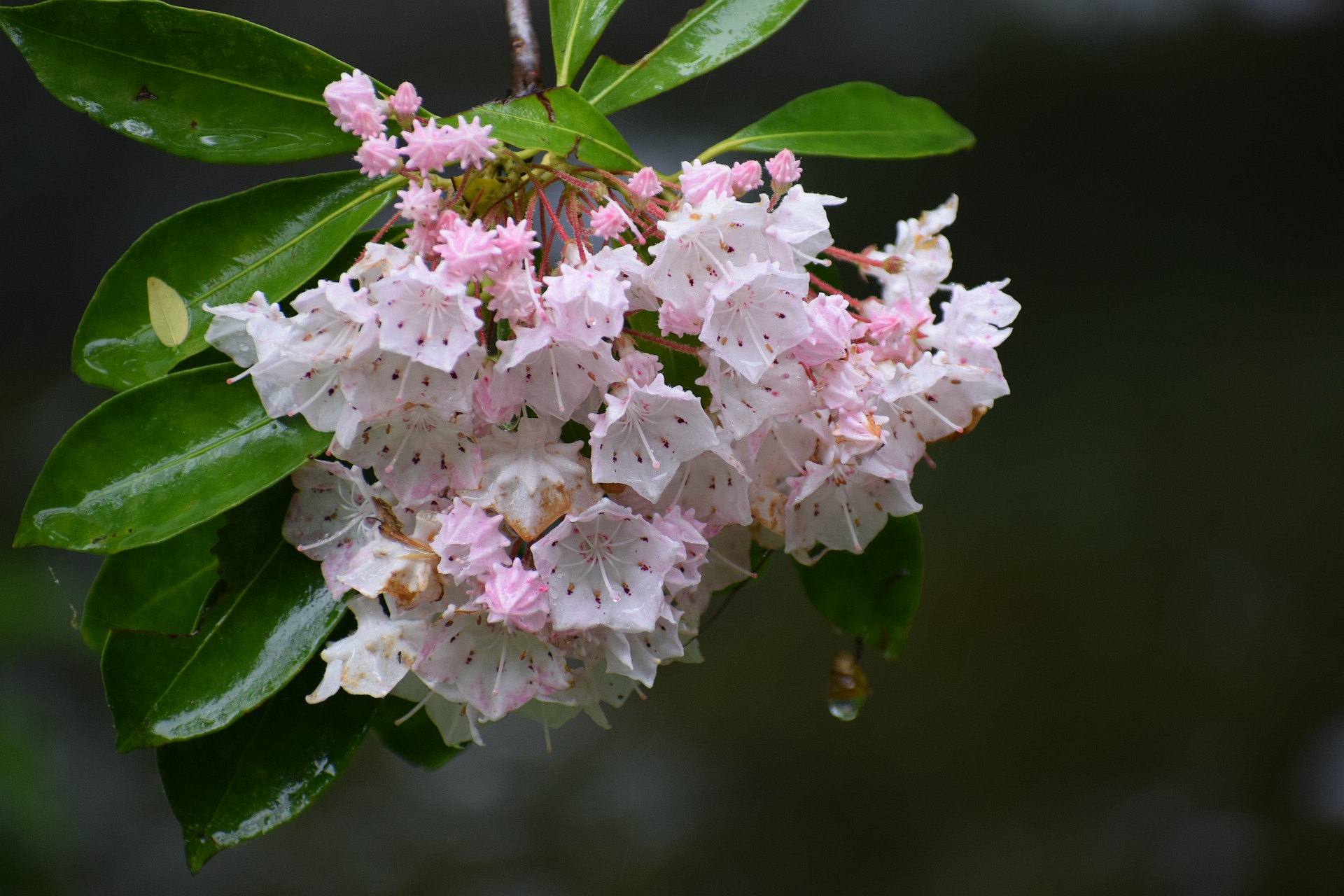
6. Mountain Laurel
(Kalmia latifolia)
Most commonly found in cool meadows and mountain slopes, Mountain Laurel is a flowering evergreen shrub that blooms from late spring into early summer.
They have oval, leathery green leaves and bell-shaped flowers that range from a white to pink color, with deeper pink spots dotting the inside of their blossoms.
While these ubiquitous flowers are known for their beauty, they often grow in large thickets that some people refer to as “laurel hells” because they are almost impossible to pass through.
So if you come across them on a hike, it’s best to just go around rather than trying to bushwhack through!
READ MORE: The 20 Best Things to Do in Blue Ridge, GA

7. Blue Violet
(Viola Sororia)
One of the most popular wildflowers in Georgia, Blue Violets can be found in a variety of ecosystems, ranging from open woodlands and wooded slopes to more developed areas like city parks.
These perennial flowers are relatively small, only growing from 4 to 6 inches high. But they are self-seeding and can easily spread across wide patches of ground.
They have heart-shaped green leaves and petals that can be blue, violet, or lilac. They typically bloom in spring, but can stick around as late as July.
Their petals contain high amounts of vitamin C and vitamin A and are actually edible.
Wild violets are commonly used in soups, salads, and stews.
READ MORE: The 10 Best Romantic Getaways in the North Georgia Mountains
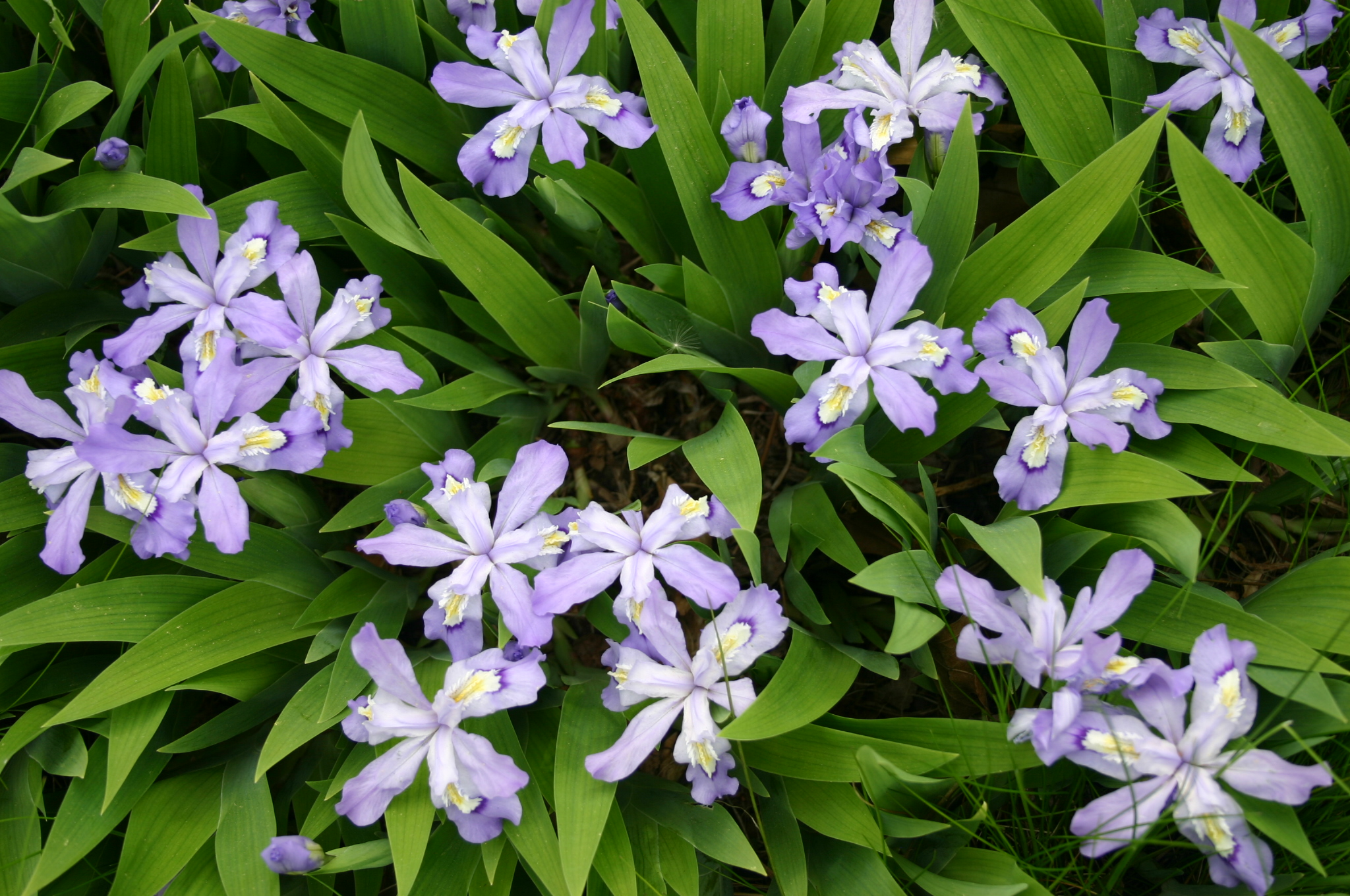
8. Dwarf Crested Iris
(Iris cristata)
The Dwarf Crested Iris is widely considered one of the most beautiful purple wildflowers in Georgia.
But it is relatively small, growing only to around 6 to 8 inches high. In fact, because of its short stature and relatively large flower, it can almost appear as if there is no stem at all.
The flower itself has 6 violet petals, with distinctive white and yellow crested markings in the center.
You can commonly find these pretty purple flowers growing in dense colonies on rocky, wooded slopes and the sandy banks of rivers and streams from March until May.
READ MORE: The 20 Best Easy Hiking Trails to Waterfalls in Georgia
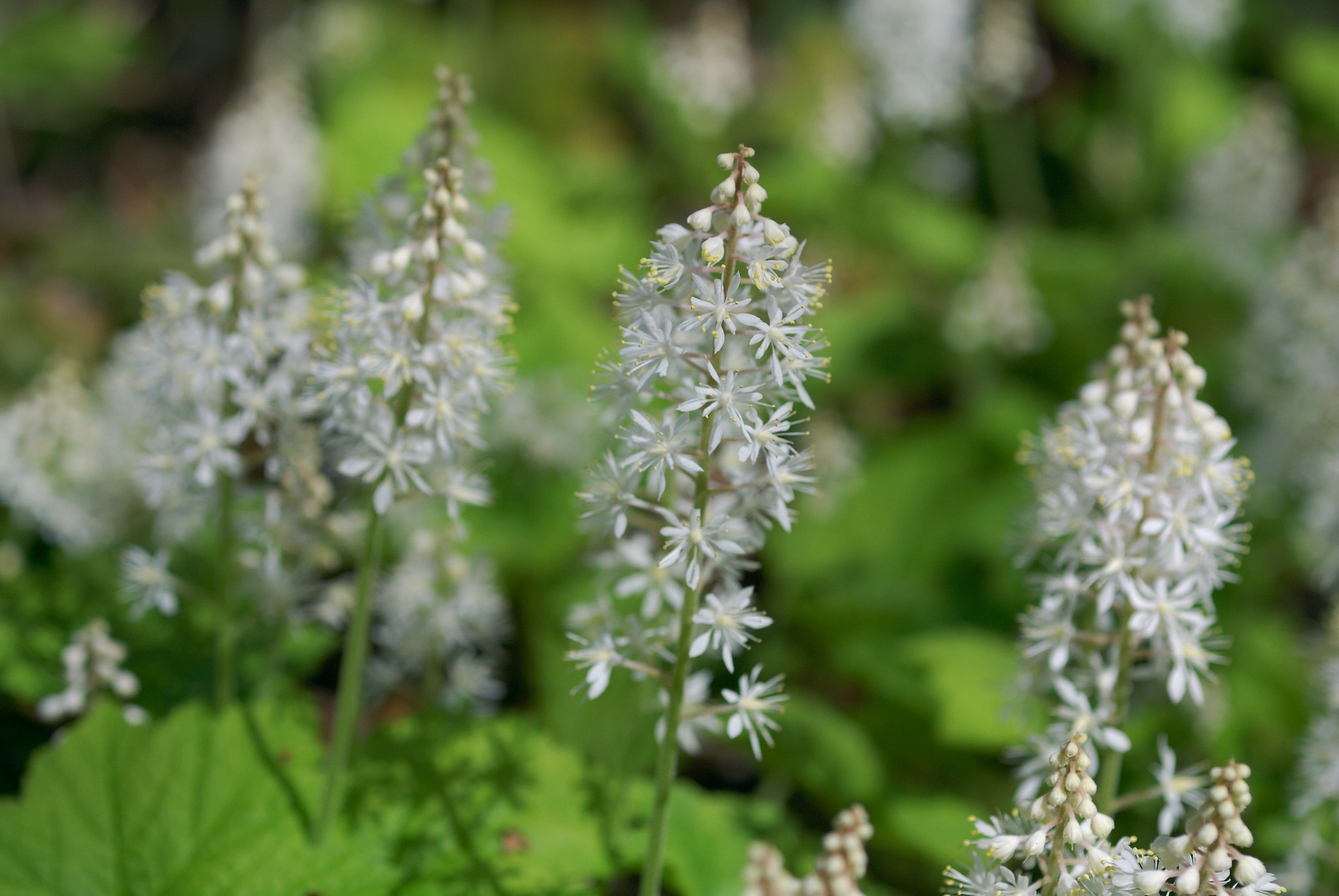
9. Foam Flower
(Tiarella cordifolia)
Foam Flowers have dark green, maple-shaped leaves and grow to a height of 10 to 12 inches, with delicate white to pinkish flowers at the top of the plant.
The groupings of tiny flowers and their airy texture resemble foam, hence their common name of foam flower.
Found in deciduous forests and along stream banks, these Georgia native flowers are clump-forming perennials that bloom from April to July.
READ MORE: The 15 Best Day Hikes on the Appalachian Trail in Georgia
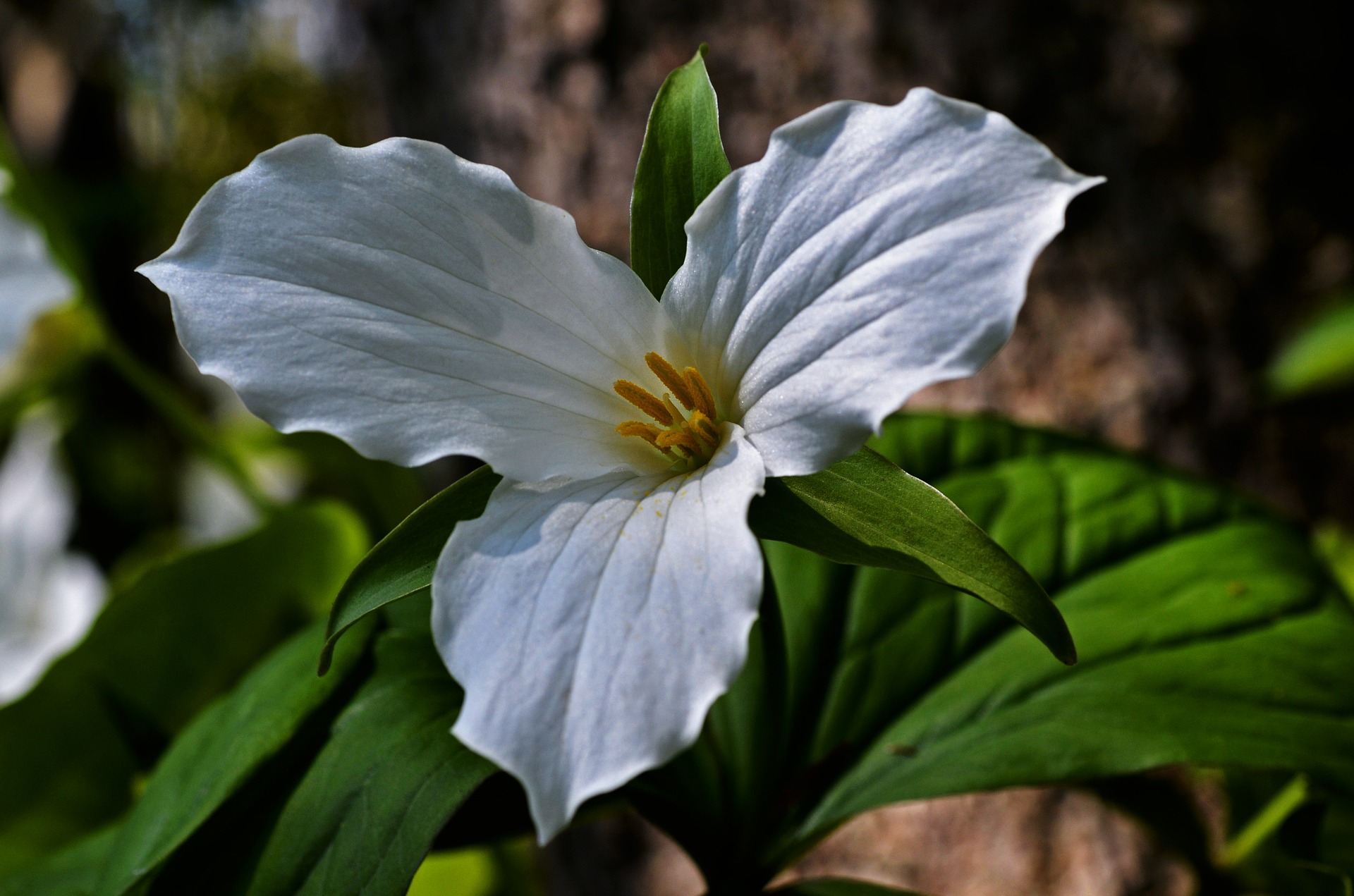
10. White Trillium
(Trillium grandiflorum)
The White Trillium is one of 22 different Trillium species found in Georgia– more than any other state.
Its cousin, Trillium cuneatum (a.k.a. Sweet Betsy), was named the Georgia Native Plant Society’s 2017 Plant of the Year.
Also known as the Large-flowered Trillium, these graceful Georgia wildflowers grow in deciduous and coniferous forests.
They’re extremely prolific and can be found in drifts of dozens to even thousands!
From a single stem that is around 12 to 15 inches, a gorgeous white flower blooms, with three white petals on top of three green sepals.
Their blooming period is from April into early June. As the flowers mature, they will slowly turn a pinkish color, then give way to berry-like capsules.
READ MORE: The Best 15 Hiking Trails in the Chattahoochee National Forest
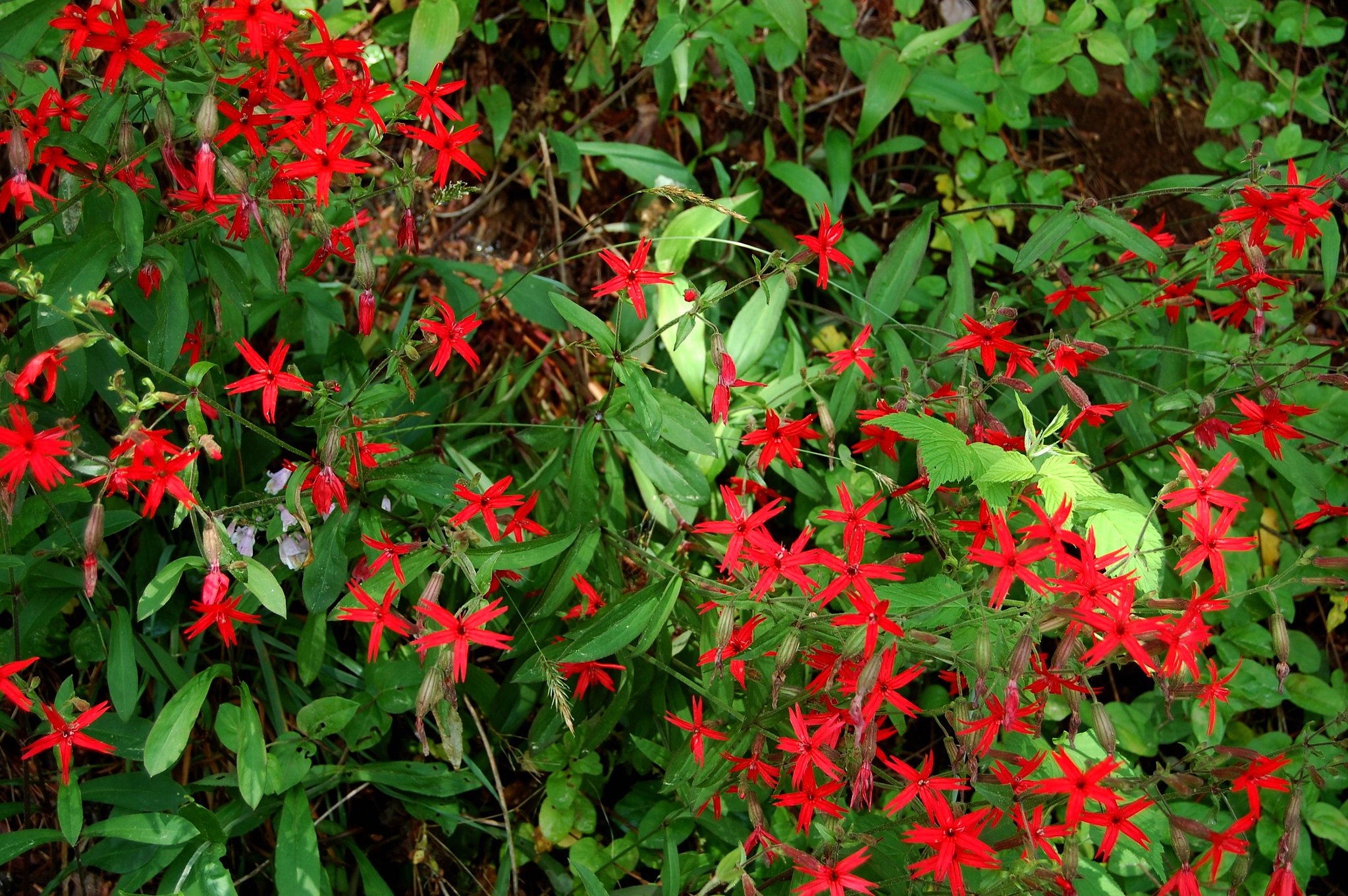
11. Fire Pink
(Silene virginicia)
These eye-catching wildflowers bloom in North Georgia from April until August on rocky slopes, mountain meadows, and even alongside scenic roads and parkways.
Despite having the word pink in their name, Fire Pinks actually produce a bright red flower with five petals, each of which has two pointed lobes.
They have sticky stems and upper leaves that trap insects, which explains the flower’s other common name– the Catchfly.
As a result, Hummingbirds (who do not need to land on the flower) are its primary pollinators.
READ MORE: The 15 Best Things to Do in Clayton GA
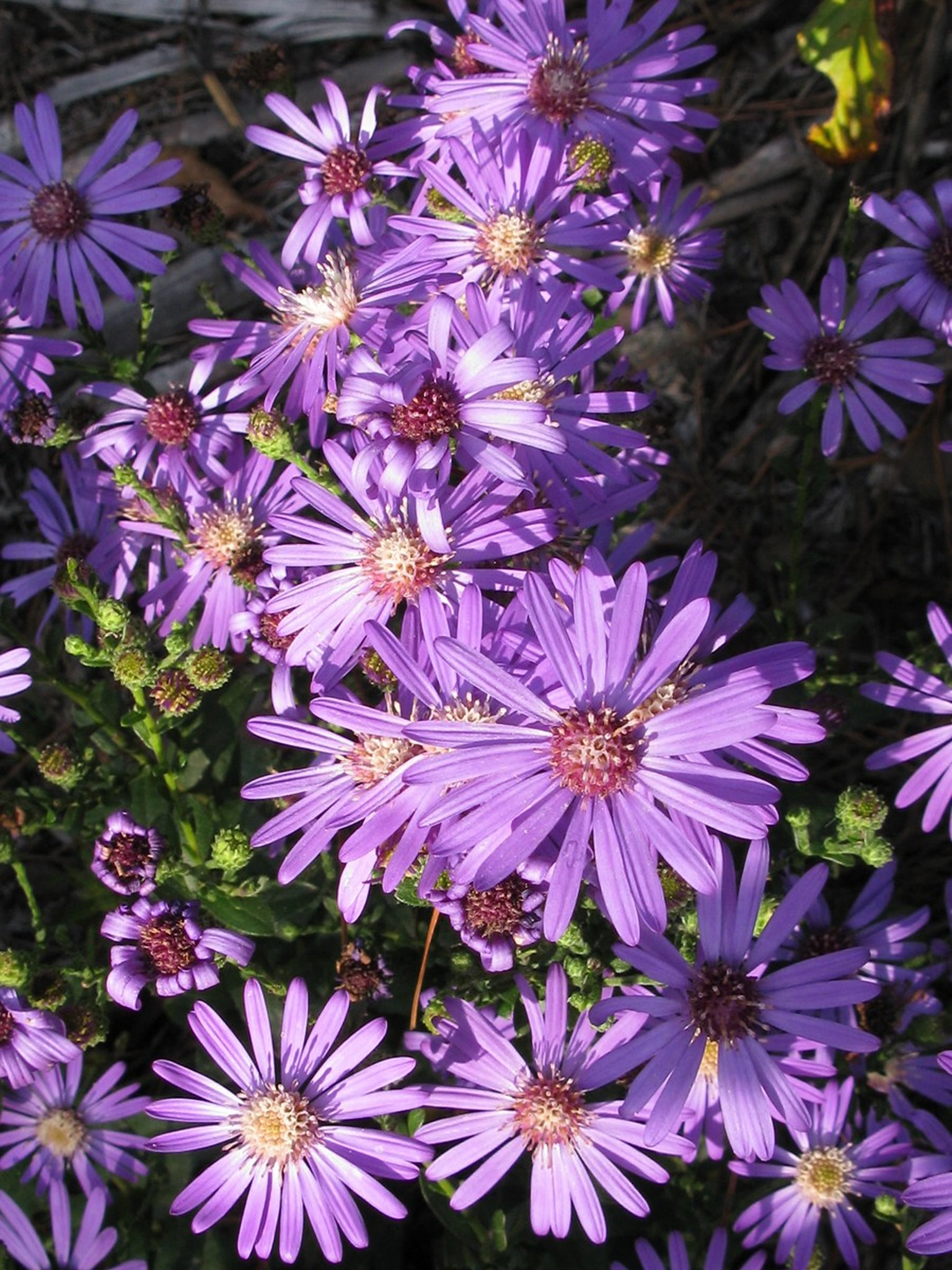
12. Georgia Aster
Named Plant of the Year in 2015 by the Georgia Native Plant Society, the Georgia Aster is a gorgeous purple perennial wildflower that blooms from late September through November.
Their stem grows anywhere from 20 to 40 inches tall, and sports a relatively large flower that can measure up to 2 inches in diameter.
While once widespread in the state of Georgia, they’re now considered rare due to years of habitat destruction.
But if you are able to spot a patch, you’ll most likely find them in open areas and rocky forests where there’s lots of available sunlight.
READ MORE: Where to See Fall Colors in the Mountains of North Georgia

13. Jack in the Pulpit
(Arisaema triphyllum)
Also known as the Indian Turnip, these eye-catching perennials are among the most unique wildflowers native to Georgia.
Rising from a 1 to 2 foot tall stem, you’ll usually find three glossy leaves and a large, hooded flower that’s green with brown stripes.
Jack in the Pulpits need lots of shade to thrive, and are often found in deciduous forest, swamps, and along stream banks.
They begin to bloom in March, and by late summer they’ll give way to a cluster of red berries, which are often eaten by the birds of Georgia and other mammals.
READ MORE: The 10 Best Waterfalls Near Blue Ridge GA
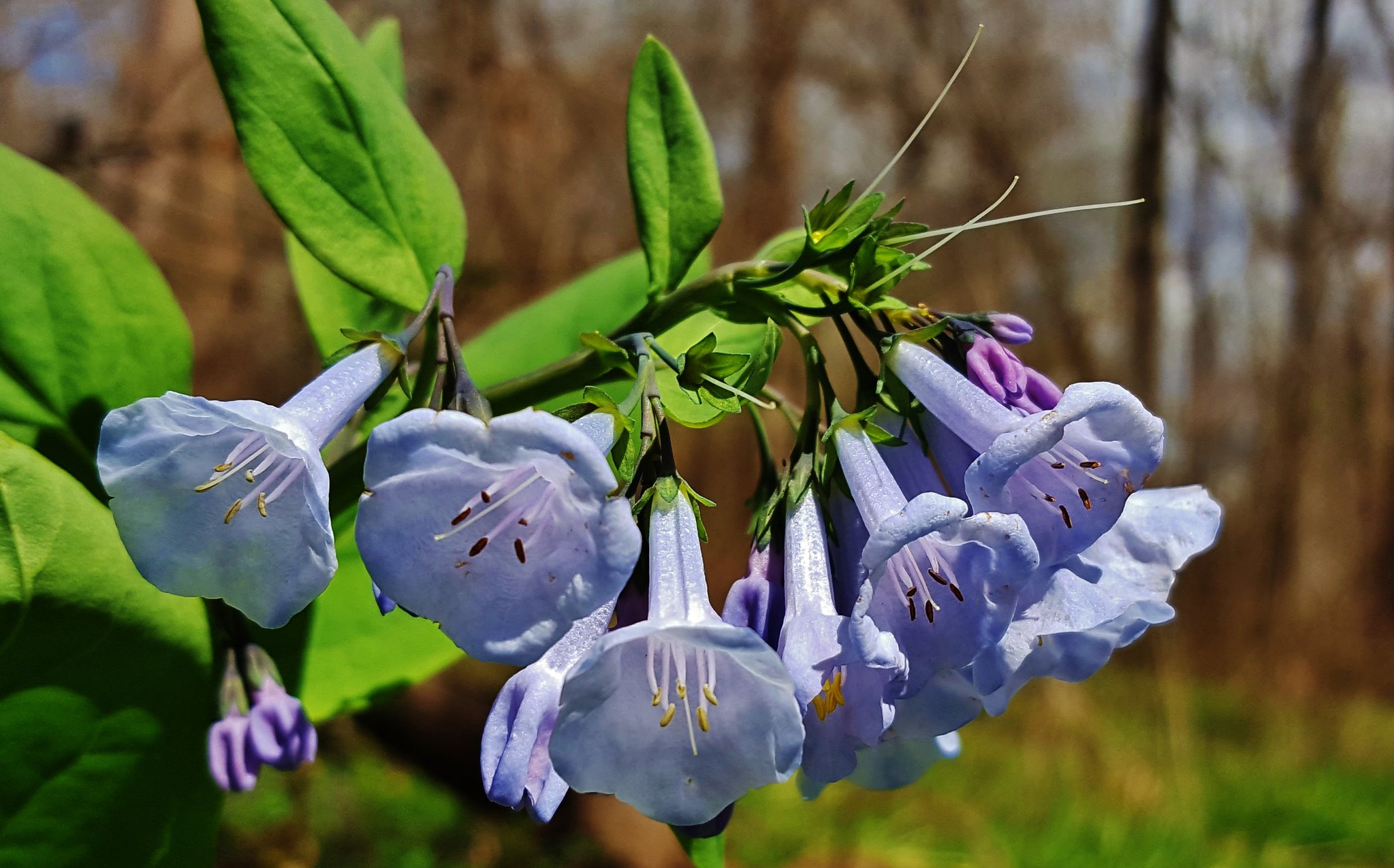
14. Virginia Bluebells
(Mertensia virginica)
Virginia Bluebells are a gorgeous blue wildflower that can be found in large clumps across North Georgia’s moist woodlands and shaded floodplains.
Their stems can grow up to 2 feet long, with large oval leaves and nodding clusters of light pink buds that bloom into baby blue trumpet-shaped flowers.
These are spring ephemeral wildflowers, meaning that they bloom in mid-spring and go dormant by early summer.
If you do get to see them in full bloom, they will usually attract lots of bees and hummingbirds!
READ MORE: The 15 Coolest Covered Bridges in Georgia
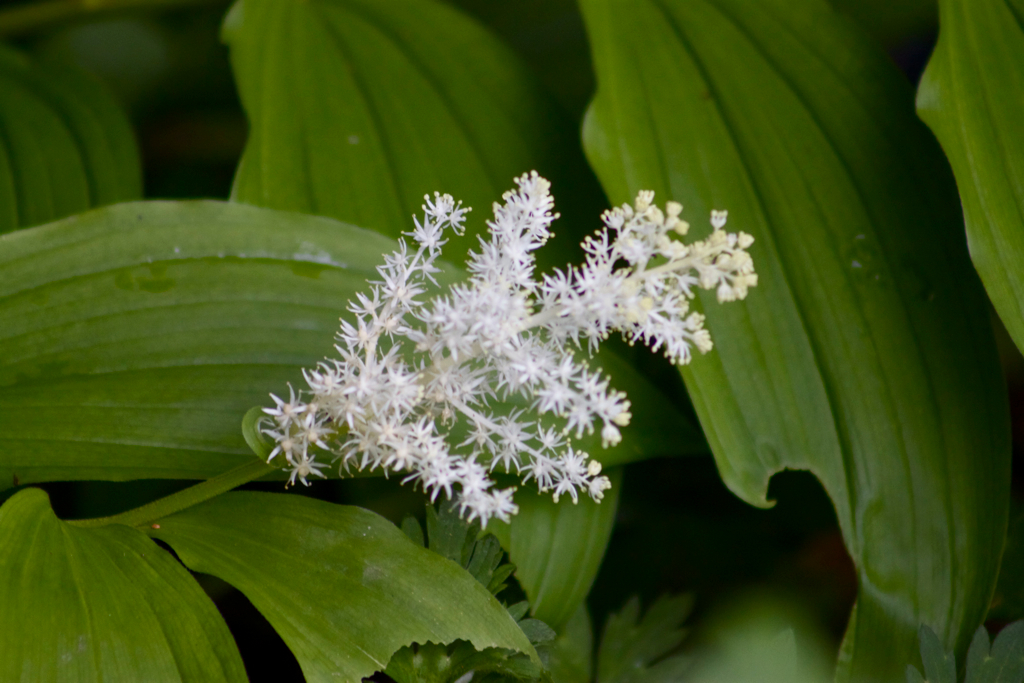
15. Solomon’s Plume
(Maianthemum racemosum)
Solomon’s plume is a perennial wildflower that grows in Georgia’s deciduous forests and fertile woodlands.
This festive flower is known by a multitude of different names, including Feathery False Lily of the Valley, False Spikenard, False Solomon’s Seal, and Smilacina.
They grow to be upwards of 3 feet, with a feathery flower cluster made up of tiny white flowers at the tip of the stem .
They bloom from March until midsummer, when their flowers turn into clusters of bright red berries.
These berries contain a few seeds each, and are often eaten by birds and mice, who disperse the seeds into new areas.
READ MORE: Things to Do in Black Rock Mountain State Park Near Clayton GA
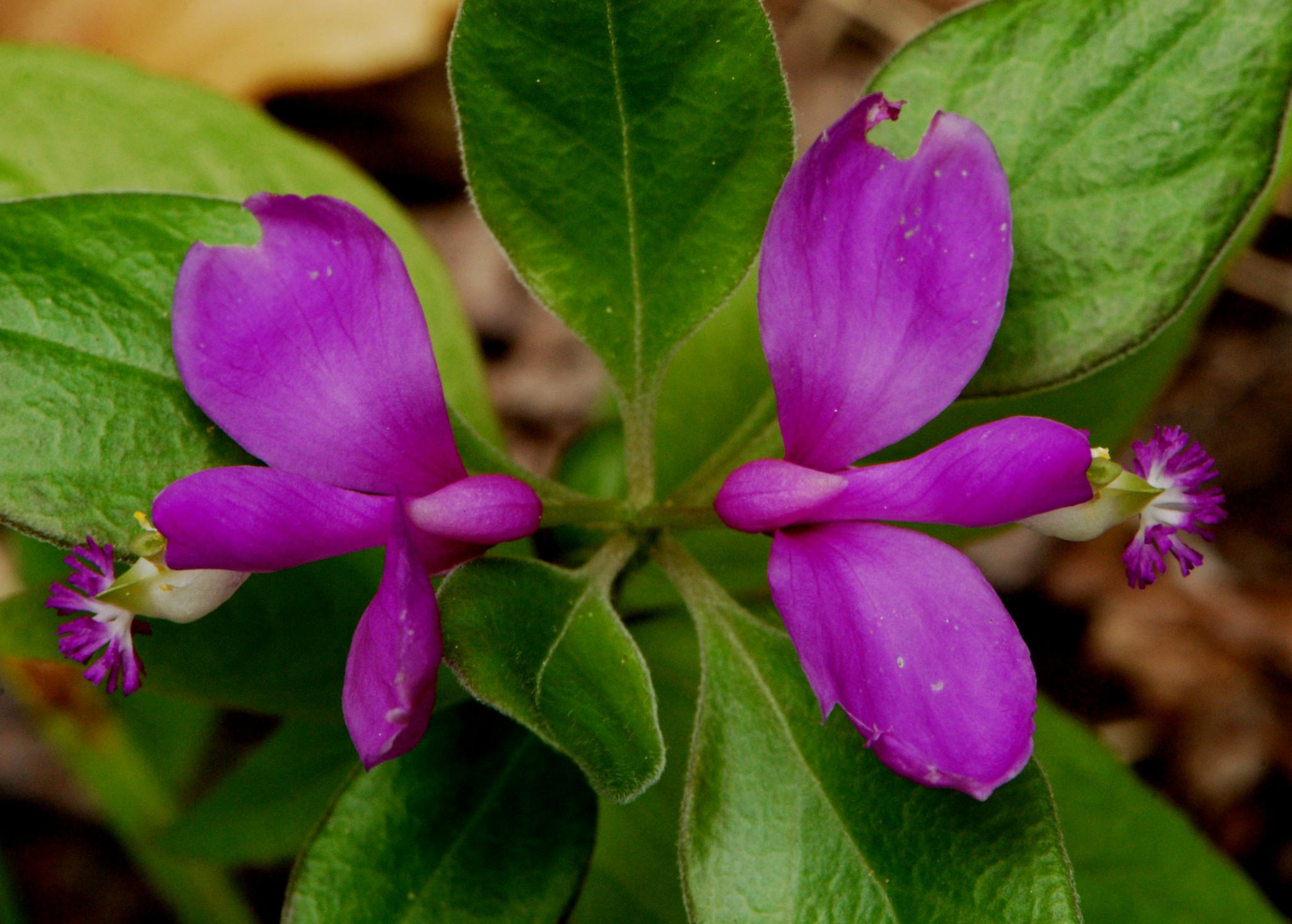
16. Fringed Polygala
(Polygala paucifolia)
Although they’re often mistaken for an orchid, these native Georgia flowers actually belong to the Milkwort family.
Impressively, they produce compounds that help to increase milk production in nursing mammals!
Also known as Flowering Wintergreens or Gaywings, the Fringed Polygala flower grows no taller than 6 inches, with a purplish pink flower and fringed petals.
They bloom from spring into early summer, and can be found in rich woodland areas and near slow-moving streams.
READ MORE: Goats On The Roof: Family Fun Near Clayton GA
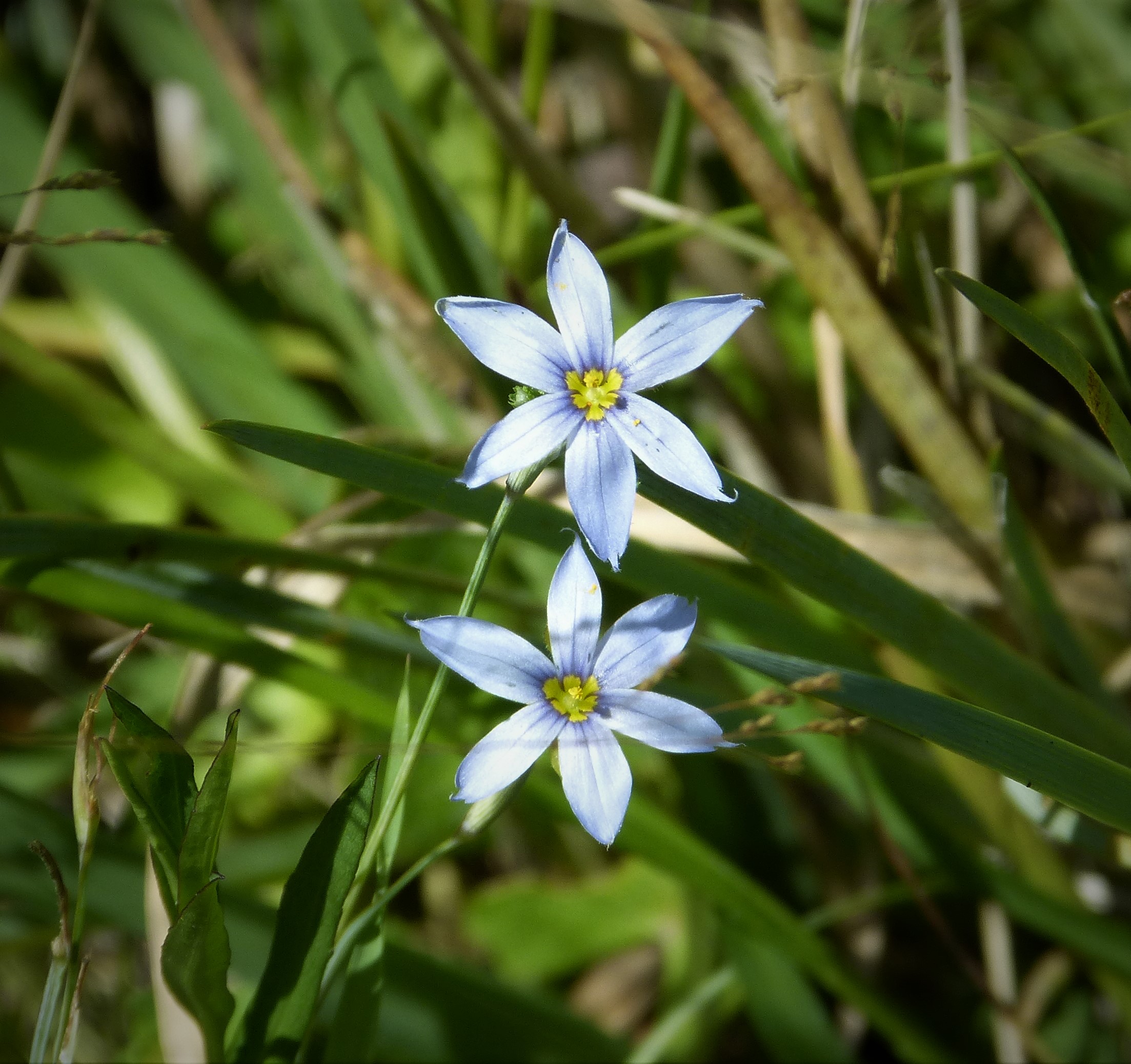
17. Blue-eyed Grass
(Sisyrinchium augustifolium)
Despite its misleading common name, Blue-eyed Grass is not truly a grass at all.
In fact, this lovely little flower is actually a member of the iris family (Iridaceae).
These clump-forming perennials have stems that can measure up to 18 inches long and bear dainty, light blue flowers with pale yellow centers.
Blue-eyed Grass needs lots of sun and can usually be found blooming in meadows and open woods from March until July.
READ MORE: North Georgia Christmas Tree Farms Where You Can Cut Your Own Tree

18. Ironweed
(Veronia gigantea)
Named for the toughness of their stem, Ironweed is a perennial wildflower that is native to Georgia.
They need ample sunlight in order to grow, and are most commonly found around streams, prairies, and meadows, where they can reach heights of up to 8 feet tall!
The long stalks dawn beautiful clusters of lavender, lilac, or deep purple flowers that attract an array of different butterflies and other pollinators.
READ MORE: How to Get to Minnehaha Falls GA at Lake Rabun

19. Mouse-Ear Coreopsis
(Coreopsis auriculata)
The Mouse-ear Coreopsis is also known as the eared coreopsis and lobed tickseed.
It blooms in the mountains of North GA from April though May, but they can produce scattered flowers until winter!
They grow in dense clumps, with stems reaching a maximum height of two feet and bright yellow flowers that rise above the foliage. The flower itself resembles a daisy, and is around two inches wide, with eight petals.
These bright yellow wildflowers grow best in full sun, primarily in woodland openings and thickets.
READ MORE: The Best North Georgia Christmas Events
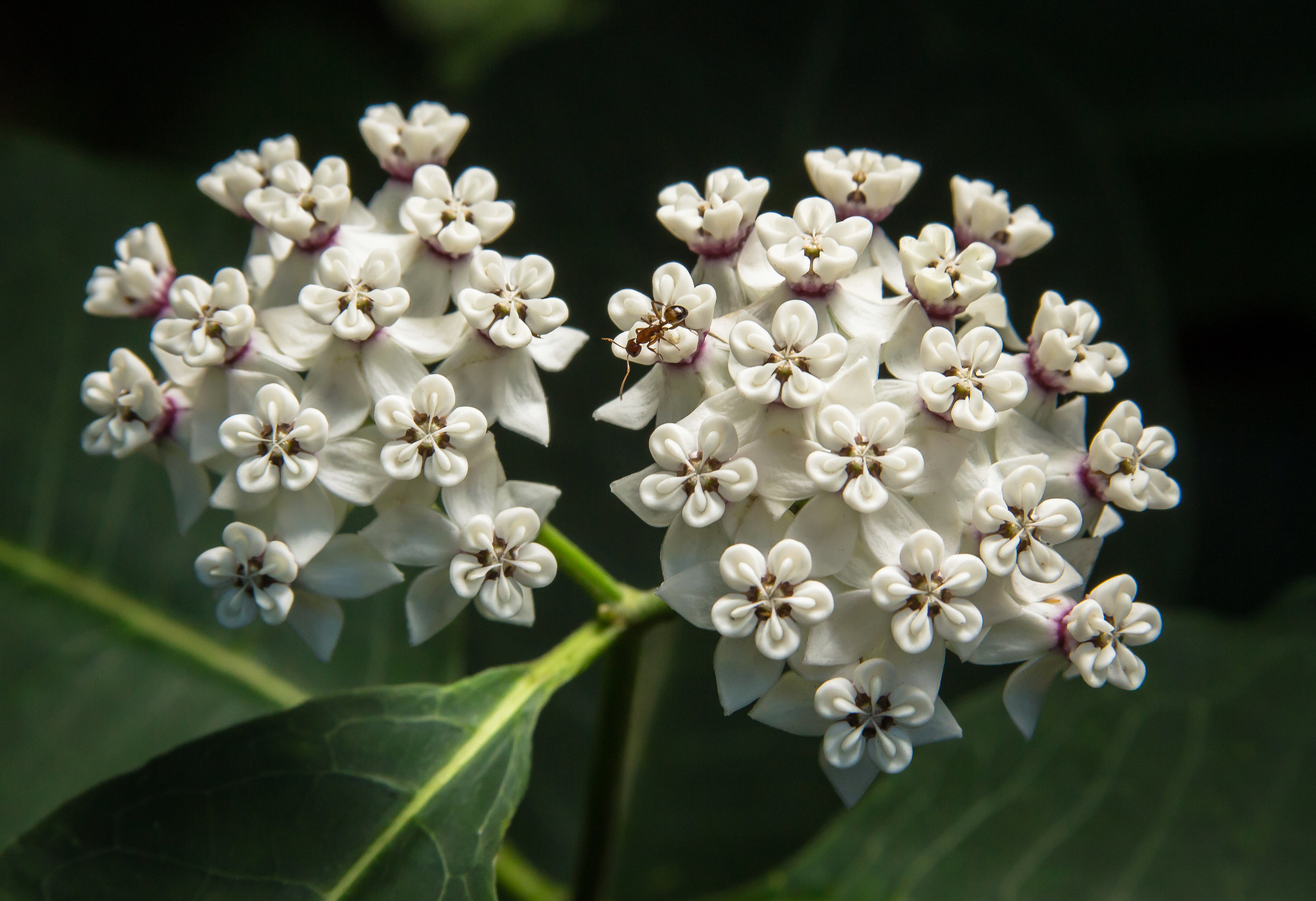
20. White Milkweed
(Asclepias variegata)
White Milkweed is a perennial wildflower that blooms from May until July in open forests, woodlands, and even along some roadsides.
They grow to be 1 to 3 feet tall, with large leaves and a spherical cluster of small white flowers with vibrant purple centers.
These wildflowers produce large quantities of nectar, and are quite popular with pollinators such as bees and butterflies.
They are also a host plant for Monarch butterflies, which often lay their eggs on the leaves of the White Milkweed.
READ MORE: Things to Do in Vogel State Park in Blairsville GA
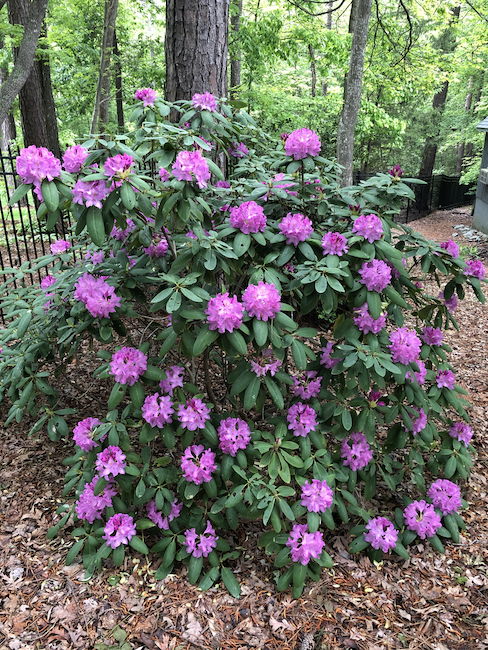
21. Catawba Rhododendron
(Rhododendron catawbiense)
Native throughout much of the Appalachian and Blue Ridge range, the Catawba Rhododendron is named for the Catawba region of North Carolina (which was itself named after the indigenous Catawba Indian Nation).
Also commonly known as the Mountain Rosebay or Purple Rhododendron, this large broadleaf evergreen shrub is often found in dense thickets alongside streams, waterfalls, and woodland slopes in North Georgia.
They typically grow 6 to 10 feet tall, with huge bugs that burst open in late spring to early summer to reveal large pink to light purple flowers.
But if the forest canopy is crowded or the soil isn’t quite rich enough, the Catawba Rhododendron can get sparse and gangly, reaching heights of up to 20 feet!
READ MORE: The 15 Best Wineries in the North Georgia Mountains
Best Wildflower Hiking Trails in North Georgia
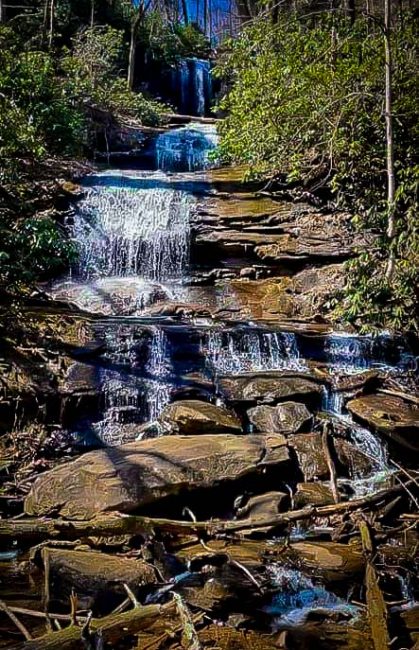
DeSoto Falls Trail
Located in the Chattahoochee National Forest near Helen GA, the DeSoto Falls Trail is a two-mile out-and-back trail that features two beautiful cascading waterfalls and plenty of wildflowers scattered throughout.
The trail begins at a parking area and follows a paved path to a wooden bridge, crossing the rhododendron-lined banks of Frogtown Creek.
Once crossed, you can see the lower falls from a wooden viewing platform. If you continue along the path, you’ll reach another viewing platform to see the cascades of upper DeSoto Falls.
Throughout the hike and near both viewing platforms, you can spot blooming Azaleas, Mountain Laurels, and patches of pink Lady’s Slippers.
READ MORE: The 20 Best Things to Do in Helen GA
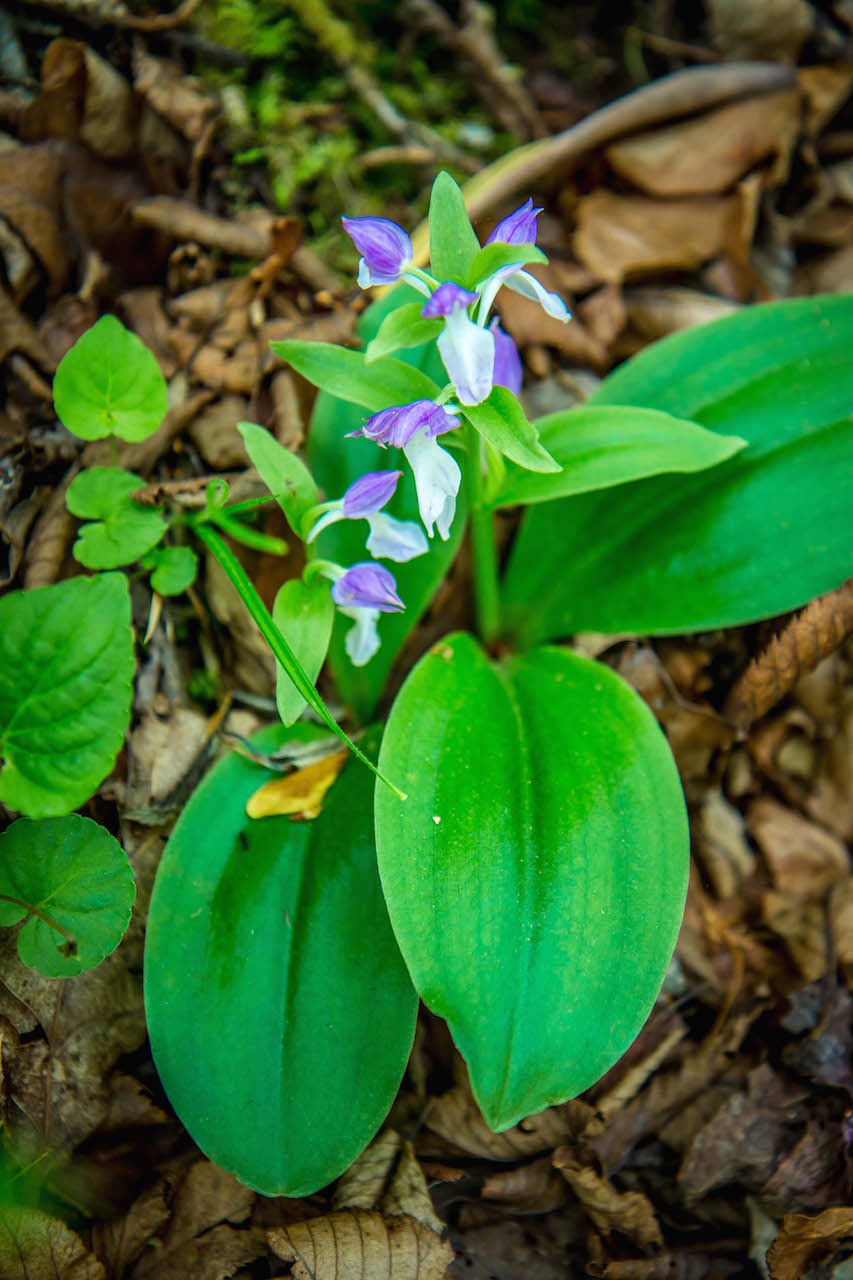
Sosebee Cove
Sosebee Cove is a 175-acre cove forest in Blairsville GA.
It was dedicated to conservationist Arthur Woody, who served as a forest ranger from 1918 to 1945.
He’s credited with bringing deer back to the North Georgia Mountains, helped acquire the land that became the Chattahoochee National Forest, and was the driving force in creating the Blue Ridge Wildlife Management Area.
Located in the Blue Ridge Ranger District, this picturesque cove has a diverse array of flora and fauna, with common sightings of White-tailed Deer, Ruffed Grouse, and even Black Bears.
The 0.4-mile loop trail that circles through the cove is extremely popular with nature photographers and wildflower enthusiasts alike, with a wide variety of stunning flowers found throughout the hike.
Commonly found along the way are Dutchman’s Breeches, White Trillium, Jack in the Pulpit, Solomon’s Seal, and a variety of native Georgia orchids.
READ MORE: The 15 Best Things to Do in Blairsville GA & Union County
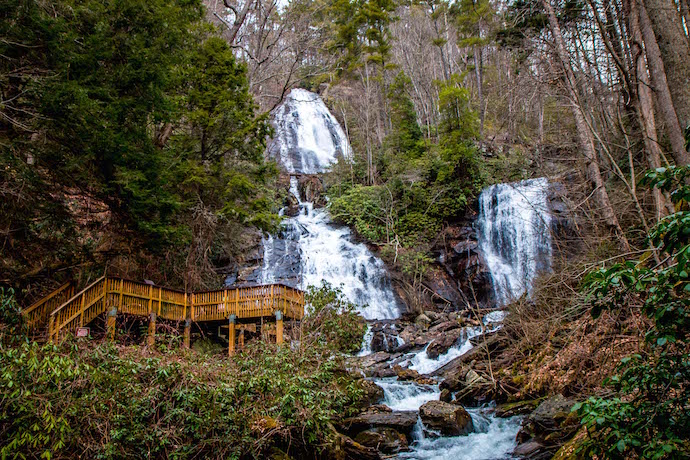
Anna Ruby Falls Trail
Although it’s very short (just 0.8 miles), the Anna Ruby Falls trail near Unicoi State Park really packs a lot in.
Starting at the Anna Ruby Falls Visitor Center, the paved path guides you along a rushing stream lined with Rhododendron.
As you walk, there are numerous interpretive signs about the area’s history, geology, and wildlife for you to browse.
The trail will take you across a bridge over Smith Creek, which provides excellent opportunities to see spring ephemerals, including a variety of Violets and Trilliums.
Continuing along the trail, you also may see Jack in the Pulpit, Blood Root, Solomon’s Plume, Foam Flower, and Fire Pink.
You’ll eventually reach several wooden viewing platforms, where you can take in the enchanting side-by-side waterfalls right up close!
READ MORE: The 25 Best Day Trips From Atlanta GA
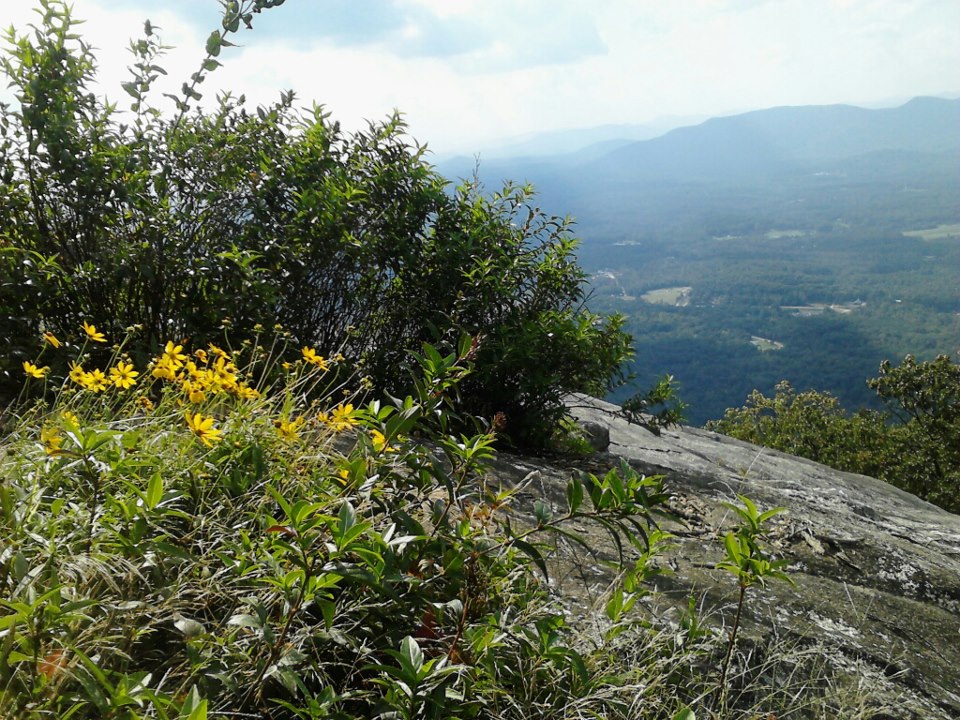
Yonah Mountain Trail
Situated between the towns of Cleveland and Helen, Yonah Mountain offers some of the best North Georgia hiking trails that feature a diverse array of wildflowers and spectacular views of the Appalachian range.
The hike to the summit begins at a trailhead off of Chambers Mountain Road, then guides you through the rocky forest where all types of Trillium, Rhododendron, and Violets grow.
At just over 2 miles, you’ll reach a picturesque mountaintop meadow of colorful wildflowers, with breathtaking views of the surrounding area.
Please use cautious at the summit, as slippery rocks near the edge of the lookout have led more than one hiker to plummet to their death there.
READ MORE: The 15 Best North Georgia Mountains for Hiking
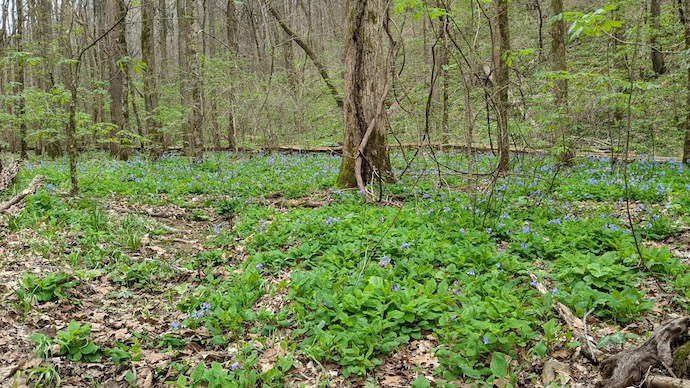
Shirley Miller Wildflower Trail
Located in Northwest Georgia’s Crockford-Pigeon Mountain WMA, the Shirley Miller Wildflower Trail is widely considered one of the best hiking trails for those who want to see wildflowers in Georgia.
Part of an area known as “The Pocket,” this 0.9-mile out-and-back trail was dedicated in honor of Shirley Miller (wife of former GA Governor Zell Miller), an outspoken advocate for non-game wildlife conservation and habitat acquisition.
The easy trail features a beautiful boardwalk, a wonderful waterfall, and nearly 50 types of native Georgia flowers along the way.
These include many of the wildflowers featured on our list, as well as Celandine Poppy, Star Chickweed, Wild Hyacinth, Yellow Mandarin, and many more.
Most stories about this beloved hiking trail will note that this is “private property.”
But all you need to do is buy a Hunting, Fishing, or Lands Pass License, which you can get online from the Georgia Dept of Natural Resources website.
READ MORE: The 10 Best Places for Ziplining in North Georgia
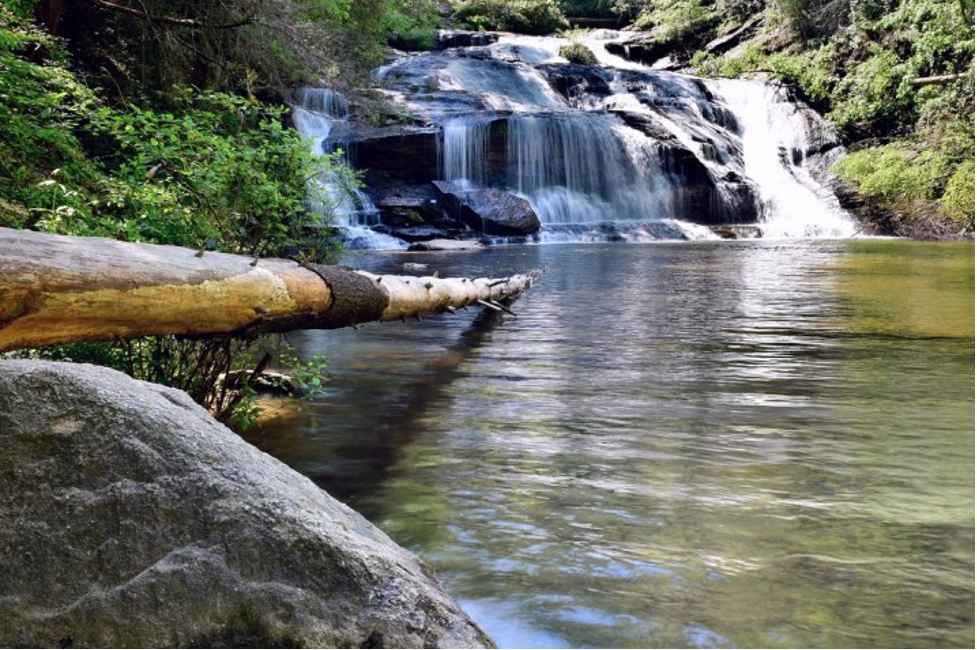
Panther Creek Falls Trail
The Panther Creek Trail is a moderately difficult hike that guides you through the Chattahoochee National Forest to a series of stunning cascading falls.
**Note that it is currently closed due to trail damage from storms as of March 2022.
As you hike through the hardwood forest, you’ll pass a variety of mossy boulders, ferns, Azaleas, Rhododendron, and Mountain Laurels along your path.
From the trailhead, it’s just over three miles to the falls.
During spring, it’s common to see GA wildflowers such as Fringed Polygala here, and as summer approaches you can spot the brilliant Fire Pink flower and various Trilliums along the way.
The hike to spectacular Panther Creek Falls and back is about 7 miles, but well worth the trek considering the bountiful array of wildflowers along the way. –by Christina Maggitas, with additional reporting by Bret Love; lead image via Canva



